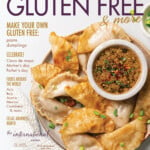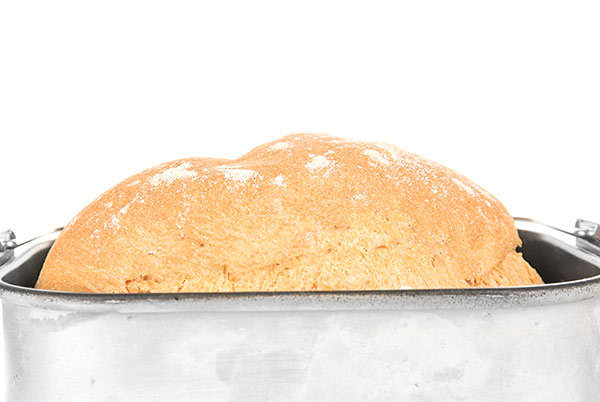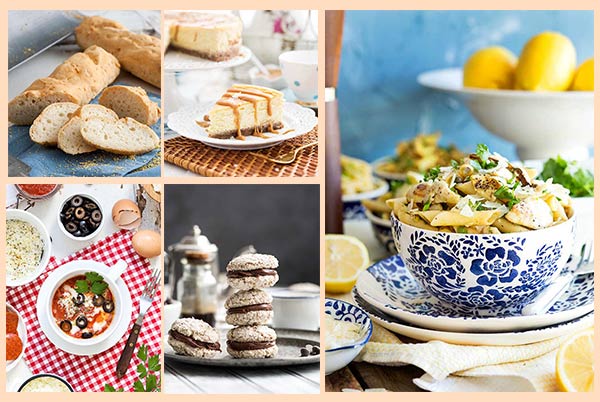This post contains affiliate links. Please see our disclosure policy.
Q: I want to make over a recipe that calls for panko. What exactly is that? What’s the difference between panko and breadcrumbs? Could I use an equal amount of gluten-free breadcrumbs instead? Can I buy gluten-free panko anywhere?
A: I’m so glad you asked! Panko crumbs and standard breadcrumbs have long been staples in a gluten-filled kitchen. Only recently have both been commercially available in gluten-free versions. Produced by several companies, these gluten-free brands are sold online and in supermarkets and natural food stores.
Panko crumbs and regular breadcrumbs are similar and can be used interchangeably. The biggest difference is texture. Panko, which has Asian roots, is a lighter, flakier crumb that creates a crispy, crunchy coating. It’s made with white bread that’s processed into large flakes and dried. Breadcrumbs are made with any type of bread; the bread is dried and then processed into crumbs.
Many people prefer panko over breadcrumbs and here’s why. Panko absorbs less oil than breadcrumbs. The result is a light, airy, delicate coating. Panko makes awesome oven-fried and deep-fried chicken, for example. Panko imparts a crunchy topping to macaroni and cheese and other casseroles. It also works nicely as a binder in meatballs and meatloaf.
Q: Can you give me a recipe for homemade gluten-free panko?
A: Here’s a quick DIY recipe. For best results, use a light-textured gluten-free white bread.
Process slices of bread into coarse crumbs with the shredding disk of a food processor. Spread crumbs on a cookie sheet and bake in a 300°F oven until the crumbs are dry but not toasted, about 6 to 8 minutes. Immediately remove crumbs from the oven and let cool. Store unused panko in a sealed container at room temperature up to a week. Freeze to extend shelf life.
Q: Please include gram weights in your recipes. The inconsistencies of measuring are why so many recipes fail.
A: To weigh or to measure, that is the question. It’s also an ongoing debate and I can understand the merits of both. Weighing ingredients is the best way to guarantee consistency each time you bake. The problem is that gluten-free flours aren’t standardized; the weight of a cup of gluten-free flour can vary by half an ounce depending on the type of flour, the grind and the manufacturer. Let’s say a gluten-free baker decides to replace 1 cup of rice flour (4½ ounces) with 1 cup of another gluten-free flour, like buckwheat (4¼ ounces) or amaranth (35/8 ounces). See what I mean? This variance could certainly change the outcome of your baked goods.
The ratio of wet to dry ingredients is critical in gluten-free baking. So discrepancy in the amount of dry ingredients could produce a baked good that’s wet in the center or overall dry and crumbly. Until there’s a standardized gluten-free flour or flour blend that’s used by everyone, we are doing our readers a disservice by printing our recipe ingredients in weights.
As an aside, I asked GF&M’s Facebook followers if they like to weigh or measure their ingredients. All but one said they prefer to measure; only one owned a kitchen scale.
Q: I made a gluten-free bread recipe and it had a bitter after taste. Any idea why?
A: When a baked recipe has a bitter taste, I usually suspect that one (or more) of the flours or starches used was no longer fresh. In the recipe you shared, I would apply the “sniff” test. Sorghum flour and tapioca flour/starch would be my first suspects. If they smell “off,” toss them.
To keep your flours and starches fresh, monitor their “best used by” dates. Store them in the refrigerator or freezer and bring them to room temperature before using. Ingredients with high fat content, like almond flour, nut flours and flax meal, should always be kept in the freezer to keep them from becoming rancid.
Q: When a recipe calls for a mixture of flours, like sorghum flour, rice flour and potato starch, can I substitute a commercial all-purpose gluten-free flour blend?
A: Yes. You can certainly use an all-purpose flour blend in place of the flours listed in your recipe. Total up the quantity of flours and starches and use that amount of an all-purpose blend instead. Check your blend to see if it contains gum (xanthan or guar). If gum is not included in your flour blend, add it according to your recipe’s instructions. The same goes for salt.
Q: Your baked desserts are full of sugar. Can I make them healthier by replacing the sugar in the recipes with natural sweeteners, like honey, maple syrup or dates?
A: You can successfully replace granulated sugar with date sugar or coconut sugar in most recipes. They aren’t quite as sweet as white sugar but they work just fine. Note that both date sugar and coconut sugar are darker in hue, which can impact the color of light, delicate cookies and white cakes. Replacing sugar with liquid sweeteners like honey and maple syrup will alter the wet-to-dry ratio in your recipe, so I don’t recommend doing that. For healthier eating, remember that baked desserts and sweets are special treats and enjoy them in moderate amounts.
Written by Beth Hillson, originally published in Gluten Free & More.













